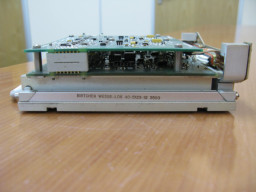Ling-Temco-Vought responded to the VA(L) competition which was for a new fighter to replace the US Navy A-4s. In March 1964 the company received a contract for the initial batch of aircraft, designated A-7. In 1965 the aircraft received the popular name Corsair II. It was the first US aircraft to have a modern HUD which displayed information such as dive angle, airspeed, altitude, drift, and aiming reticle. In 1967 it was announced from Dallas in Texas U.S.A that Elliott Flight Automation had been awarded a four year contract to supply LTV with Head Up Displays for the A-7. The initial contract was worth £14million for 1,200 displays and was the largest ever awarded to a British firm.
The highly innovative optics was manufactured by Pilkington in North Wales. It had a 5" exit lens giving a 20° TFoV and had a two position combiner. The optics incorporated a clever split prism with dichroic coatings to allow the injection of a red Standby Sight from each side which was coupled to small lamps by fibre-optics. The A-7 Electronics Unit had a flexible symbol repertoire and the more complex symbols necessitated a faster writing rate. A key new requirement was the specification for a high level of built-in test. The HUD was part of the sophisticated ILAAS weapon system and this introduced predominantly digital serial data links for the aircraft data.
By 1970 the A-7D and A-7E began to move to squadron service and pilots were reported to say that "they like it better all the time". It was doubling the weapon delivery accuracy. Also in 1970 Elliott Flight Automation was awarded a Double Queen’s Award for both Export of all products and Technology of the Digital Head Up Display. In 1971 Vought Aeronautics Corporation donated a silver cup to be known as the Corsair Trophy in recognition of the Division’s achievements in designing, developing and manufacturing the A-7 Head Up Display. Much later in 1978 the Corsair Building was opened at Rochester again to note this very important programme.
The A-7 HUD was the breakthrough into the US market and was the start of a golden era for HUDs; 2534 to of this design were made and build rates exceeded 30/month at one time.






